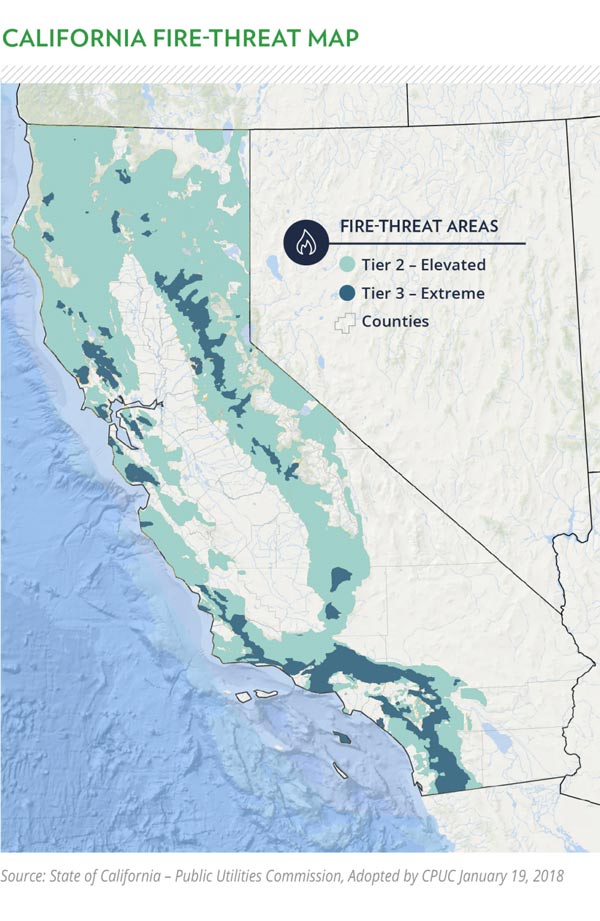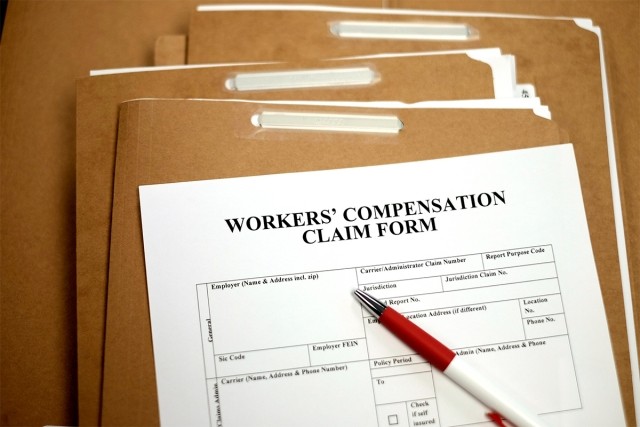Blog
Public Safety Power Shutoffs in California: Risk Management Tips and Resources
To help you stay informed about Public Safety Power Shutoffs (PSPS), here are key takeaways on this new risk mitigation effort.
To help prevent wildfires during extreme weather conditions, California electric utility companies have adopted the use of Public Safety Power Shutoffs (PSPS). Beginning in 2017, PSPS have been utilized to reduce the risk of fires caused by electric infrastructure by temporarily turning off power to specific areas. PSPS events are generally considered “last resort” efforts in response to extreme wildfire risk in the area.
For example, high winds and downed trees can disrupt electrical lines, possibly igniting fires. Also called "de-energization," PSPS is particularly important as a preventive measure during the Santa Ana fire season (October to March) and the summer fire season (June to September).
PSPS events can often be highly disruptive to commercial businesses located downstream from the de-energized circuit. Future electric utility improvements for PSPS events include grid hardening, including vegetation control, conductor covering/shielding, establishing mobile and fixed microgrids, as well as advanced artificial intelligence driven weather mapping and grid monitoring to reduce PSPS interruptions to customers.
This article will focus on new risk mitigation and preparation efforts for your business. The information applies to California’s largest electric utility providers, including Pacific Gas & Electric, Southern California Edison, and San Diego Gas & Electric. Multi-state electric utility providers operating in and out of California such as Rocky Mountain Power and Pacific Power have developed PSPS policies as well. Other regional electric power utility providers not covered in this article may have PSPS policies already implemented or in development. Check with your electric utility provider for PSPS policies that may affect your business.
What Areas Are Prone to Shutoffs?
The areas of California most likely to have a PSPS are those with Tier 2 and Tier 3 fire threats shown on the map below:

Beginning with the 2019 wildfire season, electric utilities expanded their PSPS programs to include all electric lines, both distribution and transmission, that pass-through areas at high risk for fires.
Electric utility circuits with a high likelihood for PSPS related interruption include those that are pass-through areas designated by the California Public Utilities Commission (CPUC) as elevated (Tier 2) or extreme (Tier 3) risk for wildfire.
What Factors Drive a Shutoff?
Electric utilities will call a PSPS when gusty winds combine with a heightened fire risk. Electric company officials monitor conditions across their systems and evaluate whether to turn off electric lines proactively. While no single factor will drive a PSPS, it typically is a combination of factors, including the following:
- Red Flag Warning: Declared by the National Weather Service, a red flag warning means that weather conditions are at hazardous levels and could lead to increases in wildfire activity.
- Low Humidity Levels: Humidity levels of 20% or lower can be a contributing factor to fire activity.
- Forecasted Sustained Winds: Winds generally above 25 mph and wind gusts above 45 mph (depending on location and site-specific conditions such as temperature, terrain, and local climate) can contribute to fire risk.
- Condition of Fuel Loading: Heavy fuel loading of both dried/dead and live vegetation on forest floors could promote fire spread to treetop canopies.
- On-the-ground, Real-time Observations: Electric utility companies also rely on observations from Wildfire Safety Operations Center and field crews.
No special consideration applies to critical users (like hospitals) since fire safety is considered a more significant concern than a power outage.
How Are Customers Notified?
Whenever possible, electric utility companies will provide customers with advance notice of PSPS. However, extreme weather threats can change quickly. Customers can register for notifications and updates about when power will be restored at prepareforpowerdown.com.
An example schedule for customer notification of a PSPS is as follows:
- 48 hours before electricity is turned off
- 24 hours before electricity is turned off
- Just before electricity is turned off
- During the public safety outage
- Once power has been restored
Electric utilities also attempt to provide advance notice of shutoffs through online forest mapping, and through cities, counties, and other agencies through the following means:
- Phone calls, texts, and emails to primary contacts
- Automated notifications to send alerts through multiple channels
- Customer alerts through city or county websites, Nixie, Nextdoor, and Reverse 911
- Some utilities have their own PSPS mapping resources
- Social media and local news and radio outlets
What Is the Process for Restoring Power?
Electric utility companies will restore power when they are certain it is safe to do so. They expect to be able to visually inspect for damage and restore power to most of their customers within 24 to 48 hours after extreme weather has passed.
Here are the steps they follow before restoring power:
- Wait for the Weather “All Clear.” After the weather situation has passed and it's safe to do so, crews begin patrols and inspections.
- Patrol and Inspect. Crews visually inspect the electric system to look for weather-related damage to the lines, poles, and towers. They move through the area in vehicles, on foot, and in the air during daylight hours.
- Isolate and Repair Damage. Where damage is found, crews work to isolate the area so other parts of the system can be restored. Teams work safely and as quickly as possible to make repairs.
- Restore Power. Once it is safe to energize, a crew calls the Control Center to complete the energization process.
- Notify Customers. Customers are notified that the power is back on.
Can Insurance Coverage Help?
Although they are disruptive to your business, PSPS fall outside insurable risk for which property carriers can quantify and rate.
Business continuity plans and loss control measures will offer a more fruitful risk management approach, and Woodruff Sawyer property loss control experts are available to discuss your specific concerns. For insureds fearing irreparable financial harm, please contact a member of your team to explore risk transfer alternatives.
Here are some factors to keep in mind as you plan for PSPS:
- During any outages, coverage remains in place as usual, including perils with increased vulnerability such as fire, vandalism, and burglary.
- The planned outages alone do not qualify as a covered peril to trigger business interruption coverage under most property policies.
- Service interruption coverage exists in property policies, but it typically must be the result of physical damage to property "of the type insured" at the supplier of the electricity, gas, fuel, steam, water, refrigeration, or outgoing sewage from a covered peril.
- The insurance market continues to evolve and works to find solutions for this type of exposure. Alternative risk transfer products can be explored.
Finally, we encourage clients to take the following preventive steps to help minimize disruptions from PSPS:
- Review business continuity plans.
- Perform checks on backup power systems and generators.
- Be aware if your protection systems require power (such as electric fire pumps to power automatic sprinklers) and notify your carrier of the impairment.
Additional PSPS Resources
In addition to prepareforpowerdown.com, which provides PSPS information for California's three largest investor-owned utilities (Pacific Gas and Electric, Southern California Edison, and San Diego Gas & Electric), here are some other valuable PSPS resources.
- Pacific Gas and Electric has an address look-up page and a PSPS planning map for customers.
- The Southern California Edison PSPS page has lists of affected locations and links to outage maps.
- The San Diego Gas & Electric PSPS page provides power outage maps.
- Washington, Oregon, California Pacific Power Pacific Power utility customers can find power shutoff information.
- Idaho, Montana, and Wyoming Rocky Mountain Power utility customers can find PSPS information here.
- The San Jose Mercury News offered some PSPS planning advice in 2019 that is still relevant.
- The state of California website offers power outage maps.
- The California Public Utilities Commission offers additional preparedness tips.
Table of Contents











